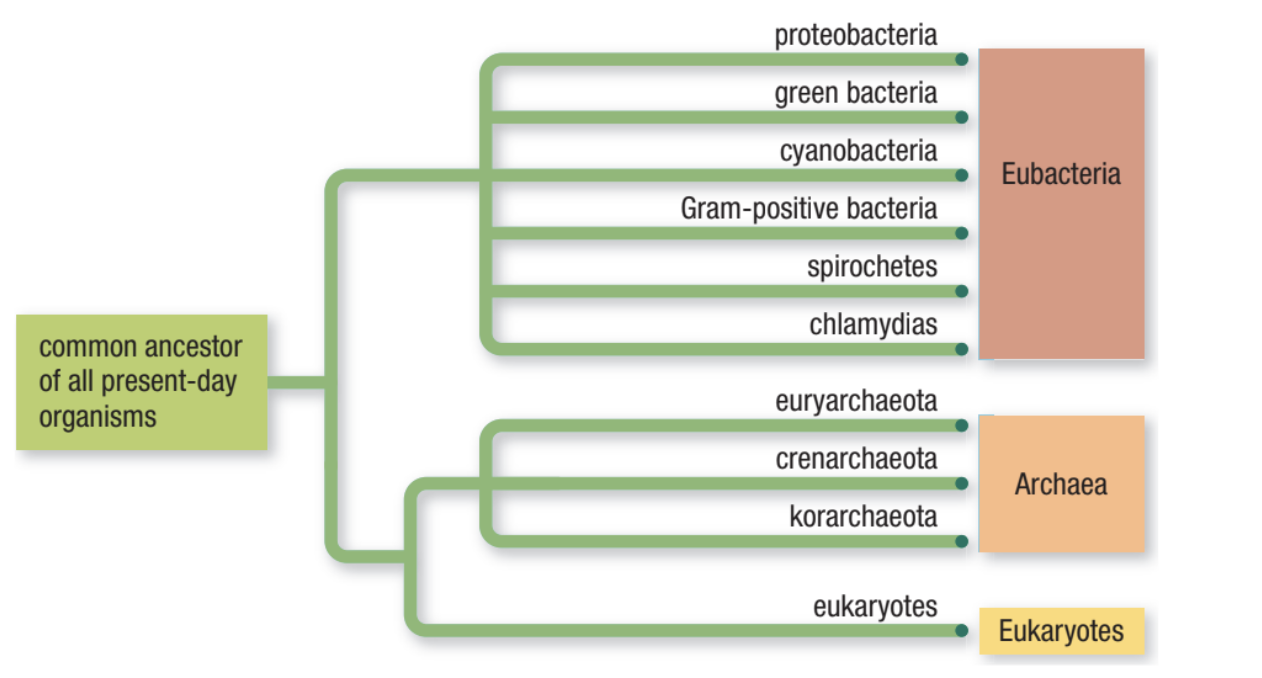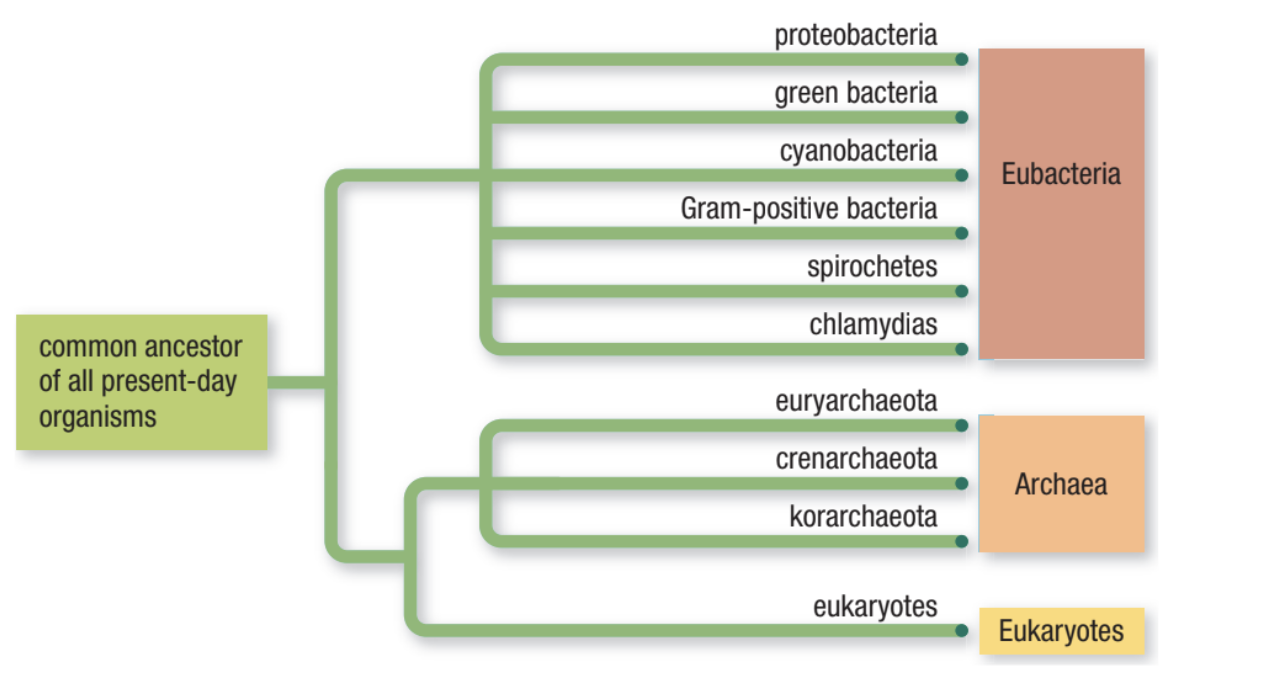Bio 2.1 - The Prokaryotes: Eubacteria and Archaea
1/66
There's no tags or description
Looks like no tags are added yet.
Name | Mastery | Learn | Test | Matching | Spaced |
|---|
No study sessions yet.
67 Terms
What are some characteristics of prokaryotes: eubacteria and archaea
unicellular organisms that lack a membrane bound nucleus and organelles
small in size
exist in every imaginable habitat
live inside/ on surfaces of other organisms, in water & soil, deep within the Earth, boiling hot springs and ice
How many prokaryotes have been observed?
Around 10,000
How come it is difficult to observe prokaryotes?
Prokaryotes are microscopic and occupy extreme environments which make them inaccessible
What are bacteria most known for?
For their harmful effects that are responsible for many diseases in humans and organisms
Pathogens (infectious bacteria)
A disease-causing agent, often a virus/micro-organism
What do pathogens do?
Responsible for diseases, such as, cholera, leprosy, strep throat, salmonella poisoning, tuberculosis
Can infect livestock and crops, which threaten our primary food sources
Can be beneficial to other species (eg. predator benefits from weakened prey)
What role does non-infectious bacteria play?
They play positive roles on Earth within our ecosystems: they act as decomposers, producers, ability to recycle nutrients, vital to biogeochemical cycles, ability to fix/convert atmospheric oxygen, important residents in the intestines of animals, and for commercial uses
Antibiotics
A substance that can kill or weaken micro-organisms
A form of bacteria and their commercial uses
Natural Antibiotics
Produced by bacteria or fungi
Synthetic Antibiotics
Produced by manufacturing
Mutualism
A relationship between two species that live in very close association with each other which results in a mutual benefit
Is humans relying on bacteria in the large intestine to produce needed K & B12 a form of mutualism? (if yes, why.)
Yes, both the bacteria and the person benefit due to close association
The bacteria live inside the intestine
The person gets K and B12 from the bacteria.
Domain: Eubacteria
Genetic evidence suggests that species within this domain diversified
Has more than 12 seperate evolutionary branches or groups
There are 6 particularly important groups of bacteria that are extremely diverse (they vary in how energy/nutrients is obtained, ecological roles, and their importance to humans)

Label 0-7 on the phylogenetic tree
common ancestor of any present day organism
Proteobacteria.
Green bacteria
Cyanobacteria
Gram-positive bacteria
Spirochetes
Chlamydias
Eubacteria

proteobacteria (purple bacteria)
Some are photosynthetic but use a form of photosynthesis that differs from that of plants.
• Ancient forms of these bacteria were the likely ancestors of eukaryotic mitochondria.
• Some are nitrogen fixing.
• They are responsible for many diseases, including gonorrhea, some ulcers, etc.
green bacteria
They use a form of photosynthesis that differs from that of plants.
• They are usually found in salt-water environments or hot springs.
cyanobacteria (blue-green algae)
They use a form of photosynthesis similar to plants and other eukaryotes.
• Ancient forms of these bacteria were the likely ancestors of eukaryotic chloroplasts.
• They play major roles as producers and nitrogen fi xers in aquatic ecosystems.
• They form symbiotic relationships with fungi.
Gram-positive bacteria
They cause many diseases, including strep throat, bacterial pneumonia, and meningitis.
• They are used in food production (for example, in yogurt and probiotic products).
• Some have lost their cell wall.
• One type—mycoplasmas—are the smallest known cells
spirochetes
Their spiral-shaped flagellum is embedded in their cytoplasm.
• They move with a corkscrew motion.
• They cause syphilis.
• Symbiotic spirochetes in termite intestines digest wood fibre.
chlamydias
All are parasites that live within other cells.
• They cause chlamydia, one of the most common sexually transmitted infections.
• They cause trachoma, the leading cause of blindness in humans.
Characteristics within prokaryotic cells are relatively…
complex
Some characteristics are…
bacterium’s chromosome, ribosomes, flagella, pili, plasmid
Bacterium’s chromosome
single loop of DNA, found in the nucleoid (one chromosome)
Ribosomes
used in protein synthesis which is scattered throughout the cytoplasm
flagella
used for movement
Pili (pilus for sing.)
small hair like structure made of stiff proteins that help the cell attach to other cells or surfaces
Plasmid
a small loop of DNA often found in prokaryotic cells within the cytoplasm; usually only contains a small # of genes
Gene/ genus from the plasmid DNA are not essential, but…
advantageous
Peptidoglycan
a large molecule that forms long chains, where they cross-link and creates a strong and rigid cell wall
Capsule
an outer layer found in some bacteria that provides protection (reduction of water loss, resistant of high temps, and keep out antibiotics/viruses)
3 common bacterial shapes
coccus (cocci), bacillus (bacilli), spirillum (spirilli)
Coccus (cocci)
a rounded bacterial cell
Bacillus (bacilli)
a rod-shaped bacterial cell
Spirillum (spirilli)
A spiral, corkscrew shaped bacterial cell
Bacteria are usually found in arrangements of:
Diplo- (pairs), staphylo- (clumps), and strepto- (strings)

Identify these shapes (left —> right)
diplococci, staphylococci, streptococci
Bacteria’s metabolism:
Diverse in obtaining nutrients and energy from surroundings
Autotrophic bacteria
Assemble complex carbon molecules from simple inorganic chemicals
inorganic chemicals
a chemical that has an abiotic origin; some organism-producing substances are considered inorganic (eg. water, co2, minerals)
Heterotrophic bacteria
obtain their nutrients through carbon containing organic chemicals found in other living organisms or their remains
organic chemicals
any chemical that contains carbon and is produced by living things; co2 is an exception (eg. sunlight & chemical energy—> sugar, fats, and protein)
Obligate aerobes
an organism that needs oxygen for aerobic respiration to generate energy (plants and animals)
Facultative aerobe
an organism that can survive with the presence/absence of oxygen and generates energy from aerobic respiration (with presence of oxygen) or though anaerobic respiration/ fermentation (without oxygen)
Fermentation
an anaerobic process that releases chemical energy from food
Obligate anaerobe
an organism that dies in the presence of oxygen, generates chemical energy through anaerobic respiration/ fermentation
binary fission
the division of one parent cell into two genetically identical daughter cells; a form of asexual reproduction
conjugation
a form of sexual reproduction in which two cells join to exchange genetic information (to increase genetic diversity)
transformation
a process in which a bacterial cell takes in and uses pieces of DNA from its environment
horizontal gene transfer
any process in which one species gets DNA from a different species; also called “lateral gene transfer”
Endospore
a dormant structure that forms inside certain bacteria in response to stress; protects the cell’s chromosome from damage
Bacteria are responsible for many diseases ranging in severity from minor
infectious bacteria cause disease by producing and releasing toxins.
What is antibiotic resistance?
from mass producing antibiotics, it allows the killing of bacteria. Except, the overuse of antibiotics can lead to bacterial adaptation and resistance, causing antibiotics to become useless
Domain Archaea
Unlike any living thing
cell membranes and walls have a unique chemical makeup and most lack peptidoglycan
genetic information that distinguishes them from bacteria and eukaryotes
inhabits extreme environments
Phylogenetic tree of Domain Archaea
3 branches in this domain

List 8-11
euryarchaeota
crenarchaeota
korarchaeota
Archaea

Representative Archaea from the Group Euryarchaeota
methanogens, halophiles, extreme thermophiles, psychrophiles
methanogens
• They live in low-oxygen environments, including swamps, lakes, marshes, etc.
• digestive tracts of some mammals (including humans) and some insects
• They generate energy by converting chemical compounds into methane gas, which is released into the atmosphere.
halophiles
• They are salt-loving organisms that can live in highly saline environments, including the Dead Sea and foods preserved by salting.
• Most are aerobic and get energy from organic food molecules.
• Some use light as a secondary energy source.
extreme thermophiles
They live in extremely hot environments including hot springs and hydrothermal vents on the ocean floor.
• Their optimal temperature range for growth is 70 °C to 95 °C.
psychrophiles
Found mostly in the Antarctic and Arctic oceans, and cold ocean depths.
• Their optimal temperature range for growth is 10 °C to 20 °C.